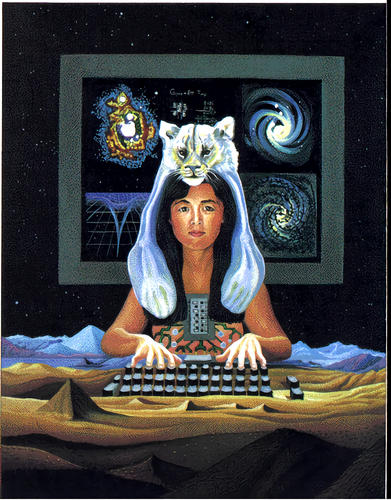As society has come to rely more heavily on advanced digital technology, art and media educators and researchers have adopted digital tools to better engage students in art curricula and approaches (Castro, Citation2012; Duncum, Citation2011; Knochel & Patton, Citation2015; Sweeny, Citation2023). They view digital artmaking that involves creative and critical process as potential for civic engagement (Bae-Dimitriadis, Citation2020; Bae-Dimitriadis & Ivashkevich, Citation2023; Buckingham, Citation2020; Cohen & Kahne, Citation2012; Ivashkevich & Keyes, Citation2022; Jenkins et al., Citation2015). Dominant media and art education is still heavily focused on how to use technologies to keep up with the ever-changing digital technologies based on technical skills. This skill-based, value-neutral approach does not provide further critical understanding of social and political contexts where media technologies are created and used, nor does it demonstrate the day-to-day impact on the daily lives of students or society (Bae-Dimitriadis & Ivashkevich, Citation2023). Thus, beyond the pursuit of coolness and skill-based effective use of technologies, the importance of critical thinking is still urgently needed.
This orientation is tremendously essential when facing current generative artificial intelligence (AI) systems, around which crucial debates are emerging as we consider the possible impacts on society, education, and business enterprises. Looking back, we can see the tremendous technological changes since the advent of the computer, World Wide Web, digitalized online platforms, and the development of hardware and software that have led to dramatic and historical world transformations. Now, our encounter with generative AI suggests that our critical assessment of new challenges and possibilities is critical when preparing for a paradigmatic shift with a new knowledge system and structural change. We manifest that our human lives and bodies are unavoidably entangled with digital machines. As shown in Donna Haraway’s envisioning of a cyborg in Citation1985, these changes produce a new way of thinking that rejects the rigid boundaries between humans and machines to address a new ontology of becoming. This new becoming proposes a positive move to reject essentialized identity politics that place men at the center of all other human and nonhuman subjects, in addition to the language that is believed to represent these identities. Rather, the cyborg refers to hybrid, fluid, contradictory bodies that blur human and machine, and accept partial and situated knowledge while also rejecting the deeply saturated Western dualistic thinking that creates hierarchy and separation of human versus nonhuman, nature versus culture, mind versus body, men versus women, and so forth. With the understanding that these generative AI bodies are a becoming from this perspective, we must provide the strategical groundwork to view AI with new conceptual possibilities that subvert the existing dominant normative imperatives that prohibit social hierarchy.
While the view attached to AI shows great promise, we must attend to an epistemological rift caused by the existing AI system. Jason Edward Lewis, who is part of an Indigenous-led science research team, identifies one problematic AI epistemological issue as the lack of Indigenous knowledge within AI due to Western-centered colonial development (New Frontiers in Research Fund, Citation2023). Lewis and his team noted that it is necessary to ensure not only the inclusivity of Indigenous knowledge in the system but also, and more importantly, the full participation of Indigenous people in shaping AI, rather than merely including Indigenous knowledge into the AI system. In addition to this issue, the possible falsification of data and algorithm bias, particularly in the ongoing mis- and underrepresentations of minoritized communities, are yet additional cases that threaten civil rights. Importantly, art and media educators must not overlook how AI magnifies and cements existing inequities, misconceptions, and discriminations, such as racism, sexism, ableism, and other forms of discrimination, since it is unregulated and unchecked. Joy Boulamwini (Citation2017, Citation2019), a Black female AI scientist and founder of the Algorithmic Justice League, has revealed coded biases in many areas, particularly those of job hiring, medical treatment, and police investigation, where these biases can be embedded within the surveillance and facial recognition software. In particular, the use of biometric surveillance technology in a school serves as a strong example. Since these biometric systems commonly gather and distribute the data from face, voice, gait, and fingerprint recognition, this can threaten a school climate and the safety of students due to inaccurate data generation and distribution (Coyle, Citation2018). This surveillance system normalizes scrutiny and control, so schools are no longer a safe space because of the pervasive monitoring and collection of students’ sensitive biometric information, thus making students feel like perpetual suspects in their own school. Particularly, for minoritized students, this invasive system can also reinforce a school’s “pipeline to prison” or “pipeline to suicide.” We urgently need to understand the educational implications and policies that concern privacy in relation to AI technologies to secure the safety, well-being, and civil rights of students, teachers, parents, and administrators alike.
Figure 1. The cover of Donna Haraway's Simians, Cyborgs and Women, a powerful collection of 10 essays written by Haraway between 1978 and 1989.

Figure 2. This photo illustration demonstrates how biometric surveillance technology commonly used in schools gathers and distributes data from face, voice, gait, and fingerprint recognition.

Since such issues are civic concerns that are expressing, navigating, critiquing, and creatively intervening into the new dominant mediascape that generative AI creates, these issues are also an important part of civic engagement and the orientation of critical media literacy. We expect our students to demonstrate a digital citizenship with ethical, equitable, and responsible use and production of AI, and thus we should envision an art and media curriculum that values such ethos to achieve social equity. As such, the articles in this issue of Art Education touch on these issues while opening a dialogue and suggesting a new direction for art educators.
The first article, “Art Education Through a Contemporary Visual Culture Lens” by Allison Aziz, reminds art educators of the importance of contemporary visual culture as it is expressed, produced, and distributed through recent advanced technologies. Next, Luke Meeken and Oscar Keyes’s article, “Critical Digital (Counter)Placemaking,” engages in the critical examination of popular digital places as colonial sites where colonial habits and sentiments are normalized. The authors introduce their collaborative creation of a digital place inspired by the decolonial counter place-making of Indigenous media artists with middle school students at a summer camp. Nicholas Leonard and Johnson Kwame Wor’s article “Addressing Algorithm Materiality and Bias Through Art: Exploring Social Media–Augmented Reality Features” also shares the urgent risks of algorithm, data, and AI that carry and perpetuate racial bias, and calls for critical digital media literacy drawing on a CRT lens. “Cultural Soundscape Mapping: An Innovative Lesson for STEAM–Multisensory Integrated Education” by Kyungeun Lim and Courtney Lonsway presents the potentials of science, technology, engineering, art, and math (STEAM) education with multisensory approaches through emerging technologies for more inclusive, innovative, and interactive learning environment. The last article “White Default: Examining Racialized Biases Behind AI-Generated Images” written by Ye Sul Park addresses the social and ethical concerns associated with generative AI images that amplify racial biases and ideologies that reinforce systemic oppression. Park further suggests a need for critical content analysis as an effective pedagogy to identify and problematize Whiteness as the default within generative AI. And finally, Nora Ramos-Vallecillo and Victor Murillo-Ligorred’s engaging instructional resource, titled “Education and Counteradvertising as a Strategy for the Promotion of Critical Thinking in Students: Deactivating Advertising With Creativity,” introduces counteradvertising as an interventional strategy by using visual cultural activities to foster students’ critical awareness of social issues.
References
- Bae-Dimitriadis, M. (2020). An anticolonial land-based approach to urban place: Mobile cartographic stories by refugee youth. Studies in Art Education, 61(2), 106–122. https://doi.org/10.1080/00393541.2020.1738177
- Bae-Dimitriadis, M., & Ivashkevich, O. (Eds.). (2023). Teaching civic participation with digital media in art education: Critical approaches for classrooms and communities. Routledge. https://doi.org/10.4324/9781003402060
- Boulamwini, J. A. (2017). Gender shades: Intersectional phenotypic and demographic evaluation of face datasets and gender classifiers [Master’s thesis, Massachusetts Institute of Technology]. DSpace@MIT. https://dspace.mit.edu/handle/1721.1/114068
- Boulamwini, J. (2019, February 7). Artificial intelligence has a problem with gender and racial bias. Here’s how to solve it. Time. https://time.com/5520558/artificial-intelligence-racial-gender-bias
- Buckingham, D. (2020). Rethinking digital literacy: Media education in the age of digital capitalism. Digital Education Review, 37, 230–239.
- Castro, J. C. (2012). Learning and teaching art through social media. Studies in Art Education, 53(2), 152–169. https://doi.org/10.1080/00393541.2012.11518859
- Cohen, C. J., & Kahne, J. (with Bowyer, B., Middaugh, E., & Rogowski, J.). (2012, June). Participatory politics: New media and youth political action. Youth and Participatory Politics Research Network.
- Coyle, S. (2018, August 28). We asked for answers on facial recognition in schools. Our questions remain. NYCLU. https://www.nyclu.org/commentary/we-asked-answers-facial-recognition-schools-our-questions-remain
- Duncum, P. (2011). Youth on YouTube: Prosumers in a peer-to-peer participatory culture. International Journal of Art Education, 9(2), 24–39.
- Haraway, D. (1985). A manifesto for cyborgs: Science, technology, and socialist feminism in the 1980s. Socialist Review, 80, 65–108.
- Ivashkevich, O., & Keyes, O. (2022). Youth policing, surveillance, and digital media performances of in/visibility. Visual Arts Research, 48(1), 29–43. https://doi.org/10.5406/21518009.48.1.03
- Jenkins, H., Ito, M., & boyd, d. (2015). Participatory culture in a network era: A conversation on youth, learning, commerce, and politics. Polity Press.
- Knochel, A. D., & Patton, R. M. (2015). If art education, then critical digital making: Computational thinking and creative code. Studies in Art Education, 57(1), 21–38. https://doi.org/10.1080/00393541.2015.11666280
- New Frontiers in Research Fund. (2023, June 21). Indigenous-led AI: How Indigenous knowledge systems could push AI to be more inclusive. Government of Canada. https://www.sshrc-crsh.gc.ca/funding-financement/nfrf-fnfr/storieshistoires/2023/inclusive_artificial_intelligence-intelligence_artificielle_inclusive-eng.aspx
- Sweeny, R. W. (2023). Digital and postdigital media in art education [Editorial]. Studies in Art Education, 64(4), 401–405. https://doi.org/10.1080/00393541.2023.2273706
